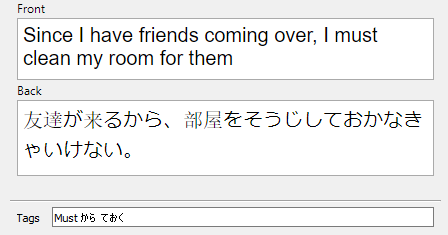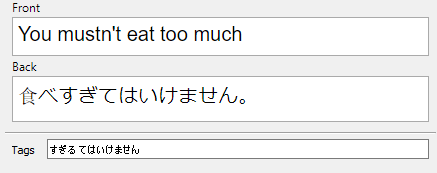Sure! So basically for each grammar point, I take 5-15 example sentences from either the grammar explanation section of the textbook or the exercises. How many sentences I use depends on the difficulty of the grammar point and how well I know it already.
I do E-J sentences, meaning the English meaning shows up and I have to translate it into Japanese. I do this for one main reason. I initially tried J-E, but when I did, I was just memorizing the card itself and not the actual grammar point, if that makes sense. By doing it E-J, it’s testing my ability to produce the answer rather than recognize it. It’s much more difficult to produce rather than recognize, and doing it this way ensures that I genuinely know how the grammar point works.
For the Japanese translation, in order to avoid unnatural language, I almost never create my own sentences from scratch. I use sentences that I find in the textbook or from other credible grammar resources. If I have to create my own, I’ll check on HiNative to make sure what I’m saying sounds correct.
As for the English translation, that’s not as important since I really just need to be able to express the English idea in Japanese. From the English translation, I mainly need to be able to recognize what grammar point is being asked. Sometimes that results in pretty unnatural, literal English translations, but it’s most important that I understand the core meaning so I can produce the Japanese.
As for reviewing and scoring and whatnot, this is what I do. When I see the English prompt, I will try to produce the Japanese in one shot. I give myself three tries to get it right. Usually when I screw up, I’ll know immediately, before I even flip the card, so as long as I haven’t flipped the card, I will try again. Once my three tries are up, I’ll flip the card and see the answer. If I answered word for word, I answer “good”. If I gave an answer that is correct but not exact, I will answer “hard”. If I completely missed the mark, I’ll answer “again”. I only answer “Easy” for grammar points that become too simple, such as XはYです and basic ます forms.
Here are a few pictures of some of my sentence cards:


In the front section, I have the English translation. On the back, the Japanese. In the tags section, I label the grammar point, that way I can search specific grammar points if I need to do a review. My cards are pretty basic honestly. I’ve been looking into plugins such as MIA Japanese which automatically adds audio to your cards, but I just haven’t gotten around to it.
As for my intervals for sentences, I go a little crazy because I want to make sure I really know the material. My intervals are 1m (initial learning), 30m, 1h, 3h, 4h, 6h, 1d. Once it hits 1 day, it graduates at a 200% ease. I only usually add 30-40 new sentence cards a week, so this keeps my workload manageable while still ensuring I retain all the material. I’ve had almost no issues with forgetting content, and when I do, the SRS usually takes care of it.
Once I finish Genki II in a few weeks, I’ve been thinking about sharing my sentence cards on the forums for anyone who is using Genki to use, but I’m not sure about the legality of it since many sentences are taken word-for-word from Genki.

